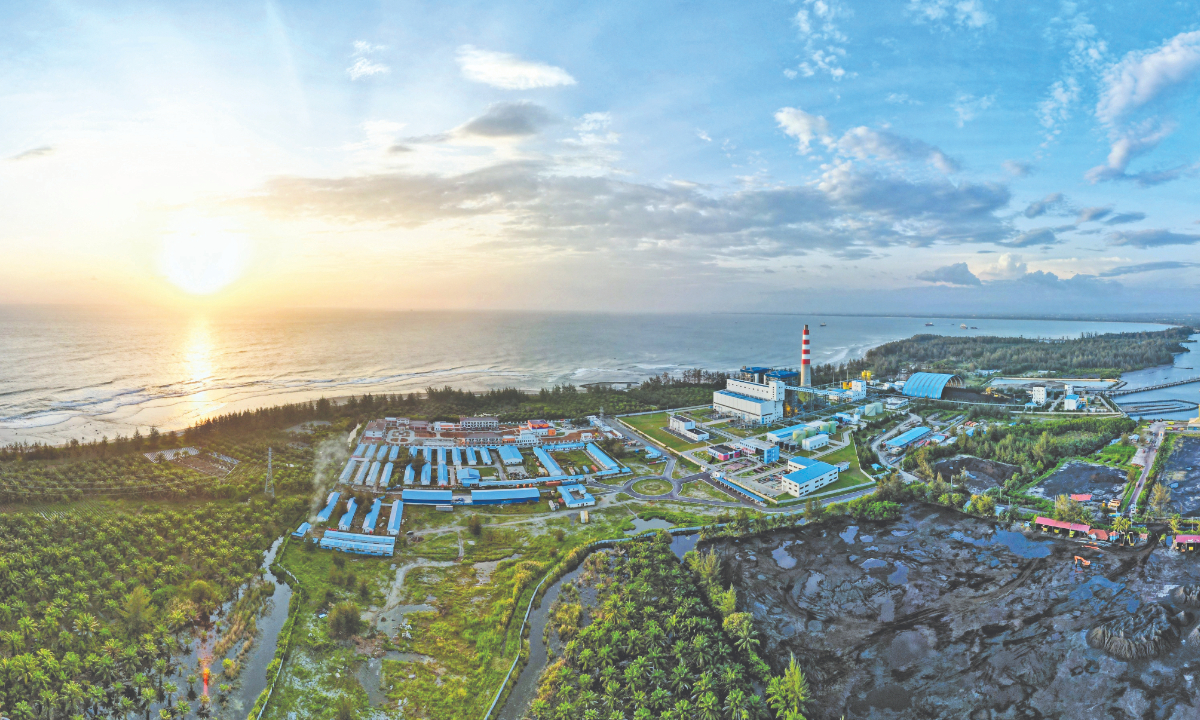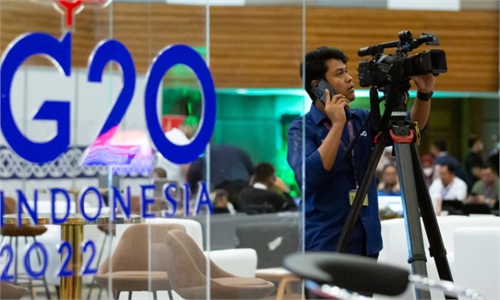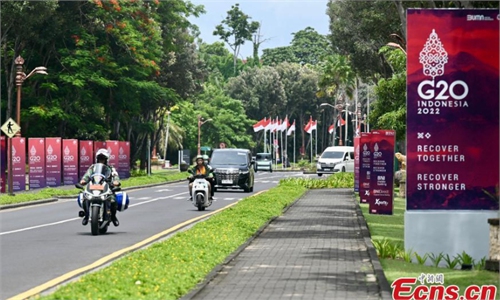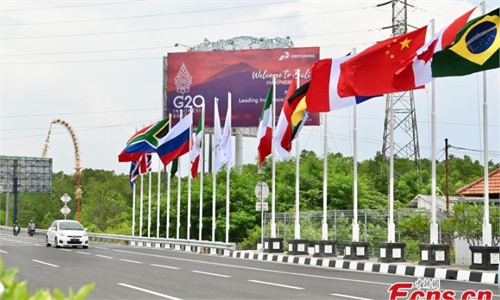ASEAN, a pilot demonstration area for BRI cooperation with China
Initiative set to stabilize supply chain, lift two economies’ standings
Editor's Note:
From November 14 to 17, Chinese President Xi Jinping will attend the G20 Summit in Bali, Indonesia. Back in a 2013 visit to Indonesia, Xi proposed that the two countries jointly build the 21st Century Maritime Silk Road, which together with the Silk Road Economic Belt, makes up the Belt and Road Initiative (BRI). Since then, BRI has been advancing at a remarkable speed, playing an increasingly crucial role in supporting the economic development of ASEAN, the world's fifth largest economy.
The world is now navigating in a confluence of acute global challenges and geopolitical tensions, against the backdrop, it is important to decode how China and ASEAN - both firmly uphold multilateralism - fast track BRI cooperation that fosters win-win results and why the initiative gains steam in a region that Washington is renewing focus but in which it has lost trust amongst member states.
This is the first in a series of articles scoping the development of BRI in ASEAN members, including Indonesia.

Indonesia, which has taken over the ASEAN chairmanship, is the place where Chinese President Xi Jinping proposed the 21st Century Maritime Silk Road - an important component of the Belt and Road Initiative (BRI) - back to a state visit to the country in 2013. Over the past decade, the mega initiative has not only sown the seeds of prosperity but also led to a series of noteworthy achievements across the bloc, making ASEAN a pilot area and a demonstration zone for BRI implementation, as well as cooperation between the world's second and fifth largest economies, forming a dynamic paradigm for the world.
Xi's attendance at the series of meetings in ASEAN is set to cement existing mutually beneficial economic ties, while injecting new momentum to the China's cooperation with the bloc under BRI, one observer said. A new chapter of BRI partnership will be unleashed, heading toward high-standard, greener cooperation, with more stable supply chains being constructed integrating China's manufacturing prowess with ASEAN's advantage in cost of production, observers noted.
Good cooperation demonstration
The Chinese Ministry of Foreign Affairs announced on Friday that Xi will attend G20 Summit in Bali, Indonesia, from November 14 to 17 and attend the APEC Economic Leaders' Meeting in Bangkok, Thailand, as well as visit Thailand from November 17 to 19.
In October, Indonesian President Joko Widodo said that the construction achievements of the Jakarta-Bandung High-Speed Railway will be presented to the world during the G20 Bali Summit, which will further demonstrate the good cooperation between the Indonesian and Chinese governments.
The 142.3-kilometer-long rail line is a landmark project under the BRI, and to date over 90 percent of the project's construction has been completed, Zeng Weixian, a senior engineer of the China Railway No.4 Engineering Group Co, a state-owned enterprise who participated in the railway's construction, told the Global Times over the weekend.
It's a key project of the exports of China's whole rail industrial chain, according to the statement China's energy infrastructure company PowerChina sent to the Global Times over the weekend. PowerChina also participated in the railway's construction.
"The China-proposed BRI integrates with the Master Plan on ASEAN Connectivity (MPAC) 2025 and is conducive to facilitate regional infrastructure connectivity. Chinese enterprises have contributed to the construction of basic infrastructure such as railway, highway, port, airport, telecom and electricity, and based upon which the two economies will foster more joint economic corridors and trade flows," Zeng said.
China has remained the largest trading partner of ASEAN for 13 consecutive years, and bilateral trade is set to grow significantly further with the implementation of RCEP.
To date, all 10 ASEAN members have signed a memorandum of understanding to join the China-proposed BRI. Other landmark manifestations of BRI cooperation include China-Laos Railway, which transformed Laos from a landlocked country into a land-linked logistic hub of ASEAN.
In addition to infrastructure, Chinese companies also invested extensively in new-energy projects, capacity and agricultural cooperation. For example, China Railway No.4 Engineering Group Co has undertaken photovoltaic projects in a number of ASEAN members including Malaysia and Cambodia.
PowerChina is also committed to the development and construction of local green-energy projects in Indonesia, Laos, Vietnam, the Philippines and other regional countries. The total contract value under construction of PowerChina in Indonesia exceeds $3 billion.
In addition to Jakarta-Bandung high-speed railway, it is also helping build the Cirata floating photovoltaic power plant, Indonesia's first floating solar PV plant being developed on the Cirata reservoir in the West Java province, which is set to become the biggest floating solar power plant in the Southeast Asia region. PowerChina is also involved in Batang Toru hydropower plant, the country's largest of its kind.
China and Indonesia also jointly launched a hybrid rice research program, and among the 80 hybrid rice varieties approved by Indonesia government, over 60 are imported from China.
"Chinese investments have propelled industrialization and modernization in ASEAN, aid in stabilizing supply chain, and the two economies' interests are now deeply intertwined, as reflected by both sides' commitment to building a closer community with shared future," Xu Liping, director of the Center for Southeast Asian Studies at the Chinese Academy of Social Sciences, told the Global Times, pointing out that this was a key reason as to why the BRI has gained wide recognition among ASEAN members.

According to Xu, deepening BRI cooperation could potentially reshape ASEAN's supply chains, and make both China and ASEAN play a more central and pivotal role in global manufacturing.
"The traditional major export markets of ASEAN members are the US and Europe. But with the implementation of RCEP and more regional capacity cooperation, it is likely that the bloc will inch toward China, taking advantage of Chinese dual-circulation policy and manufacturing strength," Xu explained.
Chinese Premier Li Keqiang on Saturday called on members of ASEAN as well as China, Japan and South Korea to keep up the process of regional economic integration and work on the stability of industrial and supply chains, when attending the ASEAN, China, Japan and South Korea ("ASEAN+3") Summit.
Observers envisioned that BRI development in ASEAN could move toward high-standard, greener and digital cooperation. "In the next stage, BRI will bring more tangible results to improve the livelihood of local residents, in particular in energy and agricultural — two sectors that have endured different levels of crisis due to geopolitical tensions," Xu said.
Pragmatic China-ASEAN cooperation also eclipsed the US' much talked about emphasis on a region it has long overlooked, analysts said, after US President Joe Biden said on Saturday at US-ASEAN Summit that a Comprehensive Strategic Partnership between the US and the bloc will help to tackle "the biggest issues of our time."
To counter what is perceived as "China's growing influence," Washington is now renewing its focus on ASEAN out of purely geopolitical gambit mindset after years of being absent. But without concrete commitment and genuine investment, Biden's pledges seem more like an empty promise, observers noted.
"The US' engagement won't affect China-ASEAN cooperation, and bilateral economic ties are set to proceed ahead under the BRI framework," Xu noted.
From November 14 to 17, Chinese President Xi Jinping will attend the G20 Summit in Bali, Indonesia. Back in a 2013 visit to Indonesia, Xi proposed that the two countries jointly build the 21st Century Maritime Silk Road, which together with the Silk Road Economic Belt, makes up the Belt and Road Initiative (BRI). Since then, BRI has been advancing at a remarkable speed, playing an increasingly crucial role in supporting the economic development of ASEAN, the world's fifth largest economy.
The world is now navigating in a confluence of acute global challenges and geopolitical tensions, against the backdrop, it is important to decode how China and ASEAN - both firmly uphold multilateralism - fast track BRI cooperation that fosters win-win results and why the initiative gains steam in a region that Washington is renewing focus but in which it has lost trust amongst member states.
This is the first in a series of articles scoping the development of BRI in ASEAN members, including Indonesia.

PowerChina participated Bengkulu 2X100MW thermal power station project in Indonesia Photo: Courtesy of PowerChina
With the holding of a series of international meetings including the ASEAN Summit in Cambodia, the 17th G20 Summit in Indonesia and the 29th APEC Economic Leaders' Meeting in Thailand, the global focus is turning to ASEAN, an economic bloc consisting of 10 Asian countries that accounts for roughly seven percent of global economic volume.Indonesia, which has taken over the ASEAN chairmanship, is the place where Chinese President Xi Jinping proposed the 21st Century Maritime Silk Road - an important component of the Belt and Road Initiative (BRI) - back to a state visit to the country in 2013. Over the past decade, the mega initiative has not only sown the seeds of prosperity but also led to a series of noteworthy achievements across the bloc, making ASEAN a pilot area and a demonstration zone for BRI implementation, as well as cooperation between the world's second and fifth largest economies, forming a dynamic paradigm for the world.
Xi's attendance at the series of meetings in ASEAN is set to cement existing mutually beneficial economic ties, while injecting new momentum to the China's cooperation with the bloc under BRI, one observer said. A new chapter of BRI partnership will be unleashed, heading toward high-standard, greener cooperation, with more stable supply chains being constructed integrating China's manufacturing prowess with ASEAN's advantage in cost of production, observers noted.
Good cooperation demonstration
The Chinese Ministry of Foreign Affairs announced on Friday that Xi will attend G20 Summit in Bali, Indonesia, from November 14 to 17 and attend the APEC Economic Leaders' Meeting in Bangkok, Thailand, as well as visit Thailand from November 17 to 19.
In October, Indonesian President Joko Widodo said that the construction achievements of the Jakarta-Bandung High-Speed Railway will be presented to the world during the G20 Bali Summit, which will further demonstrate the good cooperation between the Indonesian and Chinese governments.
The 142.3-kilometer-long rail line is a landmark project under the BRI, and to date over 90 percent of the project's construction has been completed, Zeng Weixian, a senior engineer of the China Railway No.4 Engineering Group Co, a state-owned enterprise who participated in the railway's construction, told the Global Times over the weekend.
It's a key project of the exports of China's whole rail industrial chain, according to the statement China's energy infrastructure company PowerChina sent to the Global Times over the weekend. PowerChina also participated in the railway's construction.
"The China-proposed BRI integrates with the Master Plan on ASEAN Connectivity (MPAC) 2025 and is conducive to facilitate regional infrastructure connectivity. Chinese enterprises have contributed to the construction of basic infrastructure such as railway, highway, port, airport, telecom and electricity, and based upon which the two economies will foster more joint economic corridors and trade flows," Zeng said.
China has remained the largest trading partner of ASEAN for 13 consecutive years, and bilateral trade is set to grow significantly further with the implementation of RCEP.
To date, all 10 ASEAN members have signed a memorandum of understanding to join the China-proposed BRI. Other landmark manifestations of BRI cooperation include China-Laos Railway, which transformed Laos from a landlocked country into a land-linked logistic hub of ASEAN.
In addition to infrastructure, Chinese companies also invested extensively in new-energy projects, capacity and agricultural cooperation. For example, China Railway No.4 Engineering Group Co has undertaken photovoltaic projects in a number of ASEAN members including Malaysia and Cambodia.
PowerChina is also committed to the development and construction of local green-energy projects in Indonesia, Laos, Vietnam, the Philippines and other regional countries. The total contract value under construction of PowerChina in Indonesia exceeds $3 billion.
In addition to Jakarta-Bandung high-speed railway, it is also helping build the Cirata floating photovoltaic power plant, Indonesia's first floating solar PV plant being developed on the Cirata reservoir in the West Java province, which is set to become the biggest floating solar power plant in the Southeast Asia region. PowerChina is also involved in Batang Toru hydropower plant, the country's largest of its kind.
China and Indonesia also jointly launched a hybrid rice research program, and among the 80 hybrid rice varieties approved by Indonesia government, over 60 are imported from China.
"Chinese investments have propelled industrialization and modernization in ASEAN, aid in stabilizing supply chain, and the two economies' interests are now deeply intertwined, as reflected by both sides' commitment to building a closer community with shared future," Xu Liping, director of the Center for Southeast Asian Studies at the Chinese Academy of Social Sciences, told the Global Times, pointing out that this was a key reason as to why the BRI has gained wide recognition among ASEAN members.

Graphic: Chen He/GT
Heading toward new directionAccording to Xu, deepening BRI cooperation could potentially reshape ASEAN's supply chains, and make both China and ASEAN play a more central and pivotal role in global manufacturing.
"The traditional major export markets of ASEAN members are the US and Europe. But with the implementation of RCEP and more regional capacity cooperation, it is likely that the bloc will inch toward China, taking advantage of Chinese dual-circulation policy and manufacturing strength," Xu explained.
Chinese Premier Li Keqiang on Saturday called on members of ASEAN as well as China, Japan and South Korea to keep up the process of regional economic integration and work on the stability of industrial and supply chains, when attending the ASEAN, China, Japan and South Korea ("ASEAN+3") Summit.
Observers envisioned that BRI development in ASEAN could move toward high-standard, greener and digital cooperation. "In the next stage, BRI will bring more tangible results to improve the livelihood of local residents, in particular in energy and agricultural — two sectors that have endured different levels of crisis due to geopolitical tensions," Xu said.
Pragmatic China-ASEAN cooperation also eclipsed the US' much talked about emphasis on a region it has long overlooked, analysts said, after US President Joe Biden said on Saturday at US-ASEAN Summit that a Comprehensive Strategic Partnership between the US and the bloc will help to tackle "the biggest issues of our time."
To counter what is perceived as "China's growing influence," Washington is now renewing its focus on ASEAN out of purely geopolitical gambit mindset after years of being absent. But without concrete commitment and genuine investment, Biden's pledges seem more like an empty promise, observers noted.
"The US' engagement won't affect China-ASEAN cooperation, and bilateral economic ties are set to proceed ahead under the BRI framework," Xu noted.



